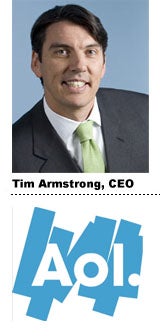 AOL’s mix of challenges and improvements to its ad business was clearly represented in its Q4 earnings last Friday. U.S. display revenues slipped 3%, dampening AOL’s triumphal announcement that companywide revenues returned to the plus side after eight long years.
AOL’s mix of challenges and improvements to its ad business was clearly represented in its Q4 earnings last Friday. U.S. display revenues slipped 3%, dampening AOL’s triumphal announcement that companywide revenues returned to the plus side after eight long years.
AOL CEO Tim Armstrong surveyed the company’s Q4 earnings in an interview on Friday, conceding that the decline in U.S. ad revenues was a problem, but noting the state of domestic advertising was improving generally for the segment. That is especially true when looking at the slice of AOL’s third party network revenues, which jumped 31% over Q4 2011. But while AOL’s strengths and weaknesses appear uneven, Armstrong sought to make the case that the company’s complete resurrection is in the twin pillars of its “barbell advertising strategy,” as represented by its programmatic tools and marketing/publishing services.
“AOL is uniquely positioned and scaled in both areas and we have a long-term strategy we are executing,” Armstrong said. “In Q4, we worked with 10% more advertisers across AOL properties and AOL networks. We sold over 30% more impressions; we did more business with Ad Age‘s top 100 marketers in Q4 than we did the year before. We grew our business with the top six agency holding companies in Q4 and quarter-over-quarter as well as year-over-year.”
Armstrong also wanted to dispute the notion that the interactive, brand-friendly Project Devil units weren’t gaining as much traction as expected. “Impressions for Devil ads were up 13% year-over-year, there are currently 52 campaigns running across AOL with 31 different advertisers and we ended up with over 200 partners in the Devil network.”
Cross-platform, with an emphasis on video and mobile, is where Armstrong said AOL will hit its stride this year. That said, he did acknowledge that consumer usage is still way out in front of advertising spending. But by getting in early, the hope is that AOL will be able to make greater headway in attracting brand dollars.
Armstrong supplied some stats to back up his confidence: Mobile reserved impressions grew 82% year-over-year, while the number of advertisers running cross platform campaigns increased by 400% since Q3. At the rechristened AOL Networks (formerly known as the Advertising.com Group), the number of publishers was up by 27%, as the unit claims 20,000 publishers and 4,000 advertiser and agency clients.
“Our DSP is currently ramping with four or five major trading desks and our total daily run rate is growing at triple digits,” Armstrong said.
The question of whether a portal business — which is what AOL essentially is, as the shrinking legacy dial-up subscription services continues to pay the bills — can adequately reform itself is something that certainly nags at AOL’s investors. Display is now dominated by Google and Facebook. This past week’s news that Google’s AdSense ad network will help fill contextual ad inventory on Yahoo suggests the shifting alliances in ad space among companies that are otherwise competitors. (Of course, Google and AOL have a 12-year search partnership in place, which helped drive AOL’s search revenue up 17% in Q4.)
Asked if the Yahoo/Google contextual deal puts any pressure on AOL to accede to Google’s display hegemony, Armstrong, a former top ad exec at Google, demurred, saying that AOL would work to grow display largely on its own.
“Our search partnership with Google is growing by double digits and we’re really happy with our progress in that area,” Armstrong said. “But when it comes to display, we’ve mainly been focusing on scaling our own organic work in that area. You’re seeing a lot of partnerships getting announced across the ecosystem. We’ve announced a whole bunch certainly, and I expect us to be principles in this space.”
Speaking of partnerships, AOL signed a much-hyped ad alliance with Yahoo and Microsoft over a year ago covering non-guaranteed inventory. When asked about the status and results of that deal, Armstrong said there wasn’t much to say about it.
“That partnership was put together to give media buyers ease-of-use at scale for tier-two, tier-three type inventory,” Armstrong said. “That’s what that deal is continuing to do. I could be wrong, but I don’t think anyone thought this was going to be any kind of game-changer. The results have been what we’ve expected – it hasn’t been above or below what we thought it would be. It got a lot of press at the time and it got attention for making it easier for media buyers to access higher quality inventory from us, but it hasn’t really gone beyond that.”
The kind of partnerships AOL is looking towards this year will likely be under the wire. AOL will pursue more “white label” services in the ad tech space, which could involve services around its recently acquired retargeting offering Buysight or its demand side platform Adlearn.
“It still looks like early days in terms of what the ad stacks that are available will ultimately look like,” Armstrong said. “If you look at all the different assets throughout the industry, both on the agency and the publisher side, the most important thing is what I would call ‘the simplified stack.’ What I mean by that is that you have a robust offering across multiple products, where the customer doesn’t have to use 15 point solutions. That causes a lot of operational difficulties and cost. Our work right now is on unifying the ad stack. Over time, there has to be a consolidation on the operational side, as the tech stack becomes more integrated.”











